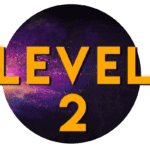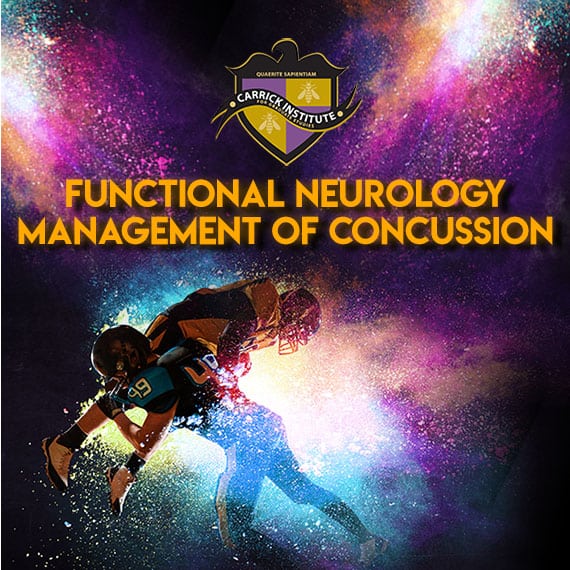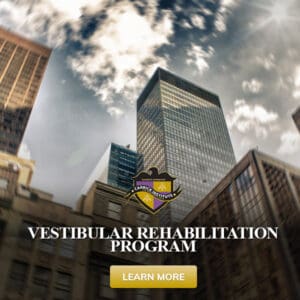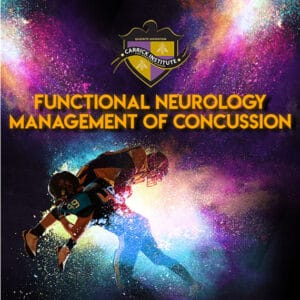
Level 2 Objectives
Chapter 1: The Entanglement of Neurological Hubs and Edges after Concussion (via online self-paced learning)
- This chapter dives deeper into the pathophysiology of concussion, leading to alterations of neurological networks that manifest as the morbidity after a concussion. Particular attention is given to mitochondrial, neurophysiological, neuroanatomical, vascular, immune, inflammatory, and oxidative stress mechanisms, disruptive equipotentiality, and their effects on functional remodeling. The goal of this chapter is to establish a basis for special testing and a rehabilitation construct for concussion rehabilitation.
- After weeks, months, and sometimes years of neuroplastic remodeling, the brain and its environment is often in a downward spiral. Chronic inflammation, hormonal disruption, autonomic dysfunction, insomnia, and other challenges perpetuate pain, suffering, injury, and poor quality of life. Research supports that more than 85% of all concussions have varying degrees of autonomic dysfunction. The autonomic function may be primary or secondary to other sensory processing abnormalities. Understanding how to critically evaluate autonomic function and compare outcomes to other sensory aberrancies allows a clinician to be more effective and efficient. This chapter will review autonomic function and dysfunction secondary to concussion. It will also delve into the downstream effects of autonomic dysfunction. In this chapter, we will discuss common metabolic, autonomic, and sleep disturbances caused by hypothalamic and pituitary dysfunction and remodeled central autonomic networks.This course has been designed to clinically apply autonomic anatomy and physiology to concussion and translate that into clinical practice. A solid understanding of the autonomic division of the nervous system will be developed, including assessment, interpretation of findings, and interventions.
- In this third chapter, we explore the complex world of cognitive function and its vulnerability to concussion in this expansive chapter of the Functional Neurology Management of Concussion. After reviewing the medical literature for topic relavence and foundation, we begin diving deep into the brain’s intricate workings that relate to the cognitive experience. Dr. Antonucci introduces and expands on his 5-level hierarchy of cognitive processing, including concussion’s effects, the effects of commonly prescribed medications, domain assessments, technology, and the clinical relevance of each level. This course is meticulously designed for healthcare professionals practicing in brain injury medicine who are fascinated by the brain’s resilience and adaptability. You will gain profound insights into how concussions affect cognitive abilities, the resilience and plasticity of the brain, and strategies for effective rehabilitation and management.
- This chapter provides a comprehensive exploration of the vestibular system, delving into its anatomy and physiology from the peripheral components to the central processing areas. It emphasizes the significance of understanding common vestibular conditions and pathologies, particularly those that often coexist with or result from concussions. The chapter thoroughly examines various vestibular reflexes, detailing both their normal functioning and the manifestations of their dysfunction. It also highlights the critical role of diagnostic procedures in pinpointing vestibular decompensation, covering techniques such as Computerized Posturography, Rotary Chair Testing, Video Head Impulse Testing, Videonystagmography (VNG), and Caloric Irrigation. Furthermore, the chapter addresses the intricate relationship between the vestibular system and different subtypes of concussion, along with associated conditions, underscoring the complex interplay that affects patient management.
- Chapter 5 in “Functional Neurology for Manual Therapies (FN-MOC)” provides a profound insight into proprioception, a key sensory system that is the second to develop during fetal growth and fundamental to human biomechanics and embodiment. It begins by exploring the anatomy of proprioception, tracing its intricate pathways from peripheral receptors to central nervous system processing.The chapter then addresses the critical integration of proprioception with vestibuloception, highlighting the synergy between these systems in maintaining spatial awareness and balance. It delves into common proprioceptive deficits observed following concussions, examining how these impairments can disrupt muscle coordination, tactile processing, and the individual’s interaction with the external world. These deficits are connected to broader somatic syndromes commonly associated with concussions.In addition to proprioception, the chapter expands its scope to discuss the role and impact of olfaction and gustation, senses that are often overlooked but can be significantly altered in the event of a concussion. Furthermore, it explores auditory processing in concussion, emphasizing the potential changes in auditory perception and processing that can occur.Overall, this chapter aims to equip scholars with a comprehensive understanding of the neurology of proprioception and its critical relationship with concussion, emphasizing its role in balance, spatial awareness, and the overall sense of self. It underscores the multidimensional effects of concussions on sensory systems and the importance of a holistic approach in concussion management.
- Chapter 6 of “Functional Neurology for Manual Therapies (FN-MOC)” focuses on the quantification of visual and oculomotor dysfunctions commonly associated with concussions. Acknowledging the human visual system as the most dominant sense, the chapter emphasizes that about 80% of the brain’s environmental information is derived from visual input. It explores the complex coordination of intra-ocular, extra-ocular, facial, and neck muscles that the brain employs to control this visual input.The chapter provides a detailed look at the anatomy and physiology of the visual and oculomotor systems, mapping their journey from peripheral mechanisms to central processing. It covers the basics of visual refraction and delves into special testing methods for the visual system, including color processing, stereopsis, accommodative range, ocular alignment, VEPs (Visual Evoked Potentials), ERGs (Electroretinograph), and more.Significantly, the chapter examines various oculomotor functions and pathologies such as accommodation, ocular alignment, ocular reflexes, gaze maintenance, saccades, pursuits, and vergence. Each aspect is explored in the context of their impact on human functioning and their alteration following a concussion.Finally, the chapter addresses rehabilitation strategies for visual and oculomotor pathologies that are commonly associated with concussions. These strategies are crucial for restoring and improving visual and oculomotor functions, which are essential for daily activities and overall quality of life. This chapter aims to provide a comprehensive understanding of the visual and oculomotor systems in relation to concussion, enabling effective assessment and treatment.
- This three-day on-site course designed for the implementation of all diagnostic testing taught in Chapters 1-6 offers an intensive, hands-on learning experience for healthcare practitioners. This course is meticulously structured to cover the comprehensive range of diagnostic tests and procedures outlined in the first six chapters of the curriculum, providing a practical, real-world application of theoretical knowledge. Each day is dedicated to in-depth sessions focusing on different sets of diagnostics, ensuring a thorough understanding and hands-on experience in each area. Participants will have the opportunity to work with state-of-the-art diagnostic equipment and tools, under the guidance of expert instructors who provide personalized feedback and instruction. This interactive environment is ideal for reinforcing learning, allowing practitioners to refine their diagnostic skills through practice and direct application. The course is especially beneficial for those looking to enhance their proficiency in a wide array of diagnostic techniques, from basic assessments to more complex procedures, ensuring they are well-equipped to apply these skills in their clinical practice.
- This chapter offers a comprehensive and practical approach to understanding and treating concussion-related vestibular issues. It provides a blend of theoretical knowledge and practical training, focusing on the autonomic and vestibular systems’ roles in concussion. Attendees learn applications to treat dysfunctions in these systems, which are often impacted by concussive injuries. The chapter offers a blend of scientific theory and evidence-based practices, ensuring participants come away with a thorough understanding of how to effectively manage and rehabilitate concussions with a focus on autonomic and vestibular dysfunctions.
- In Chapter 9, learners will explore the nuances of sensory integration therapy, understanding how to address sensory processing issues that often arise post-concussion. The course also delves into orthoptic exercises, teaching participants how to implement these eye exercises to improve vision problems and eye coordination affected by concussive injuries.Additionally, the course covers the layering of cognitive function therapies, a crucial aspect of concussion rehabilitation. Participants will learn strategies to enhance cognitive recovery, including memory, attention, and executive function exercises, tailored to the needs of individuals recovering from concussion.
- This intensive workshop for professionals who have completed Chapters 1-9, studied the theoretical aspects in these chapters, and are now eager to translate this knowledge into practical skills. Throughout the three days, attendees engage in a series of workshops and exercises that focus on the core rehabilitation strategies, principles, and techniques outlined in the chapters. The course structure allows for proficiency and hands-on practice under the guidance of experienced instructors. Participants will work in small groups to ensure personalized attention and an opportunity to practice and refine their skills. This course is particularly beneficial for those looking to apply complex concepts in a real-world setting, as it bridges the gap between theoretical learning and practical application. By the end of the workshop, attendees will have gained not only a deeper understanding of the material from Chapters 8 and 9 but also the confidence to implement these strategies in their professional practices.Dr. Antonucci masterfully sets the stage for this next Level of the Functional Neurology Managment of Concussion by exploring the unique and complex ways our brains react to these injuries. Taking a contraversial detour from the popular localization theory of neurological rehabilaition, he creates a compelling case for the rehabilitation of functional-networks, by deconstructing how the brain processes information. He delves into the nuanced interplay between neurological networks, sensory inputs, and individual physiological differences. This chapter is the foundational underpinnig for the creation of a case-specific concusison rehabilitaiton program. Whether you are an aspring concussion expert with Level 1 under your belt, or a seasoned healthcare professional, buckle in and prepare to jump in the deep end of concussion management.
Program Structure
This 2-level program utilizes a specific pedagogy to ensure the best learning experience for attending clinicians, while also making it available to clinicians worldwide.
FLIPPED CLASSROOM
A flipped classroom is a style of blended learning that introduces crucial foundational concepts before the main lectures and applications are taught. This allows all scholars to enter the main program on the same level and encourages deeper learning on more advanced topics during the main lectures.
INTERACTIVE ASYNCHRONOUS LEARNING
Interactive asynchronous learning allows you to learn on your own schedule. The main lectures are pre-recorded and will be available 24/7 on your online learning portal. Our online learning features interaction through knowledge-check questions embedded throughout the lectures, quizzing, and submission of open-ended written competency evaluations. The material will remain on your learning portal as long as one maintains an active Carrick Institute account. We encourage scholars to review the material several times for the best learning experience.
ONSITE-LEARNING
To achieve certification status, one must attend the onsite portion for each level. The onsite learning will carefully instruct clinicians on the hands-on skills they need to know for proficiency in the management and rehabilitation of concussions.
Level 1 & Level 2 both have an onsite module that is required to attend to receive certification status. Level 1 – Chapter 4 (Creating and Performing a Baseline Assessment): 3 days onsite (25 neurology hours) Level 2 – Chapters 7 and 10 (Diagnostic and Therapeutic Procedures Workshop): 3 days onsite (25 neurology hours) each Those who complete BOTH Level 1 & Level 2 of Functional Neurology Management of Concussion will be eligible to sit for the FABBIR board examination from the ACFN.





